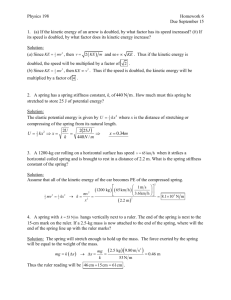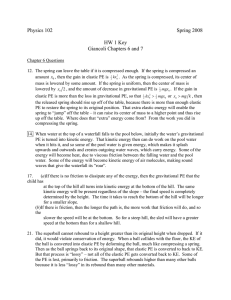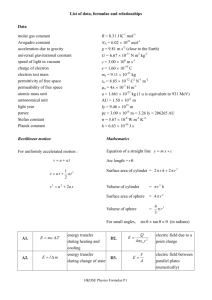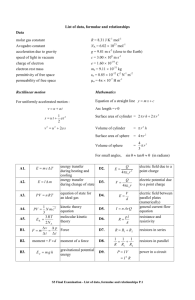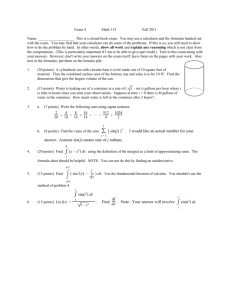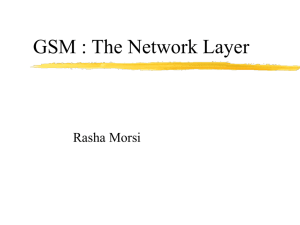Solutions #7
advertisement
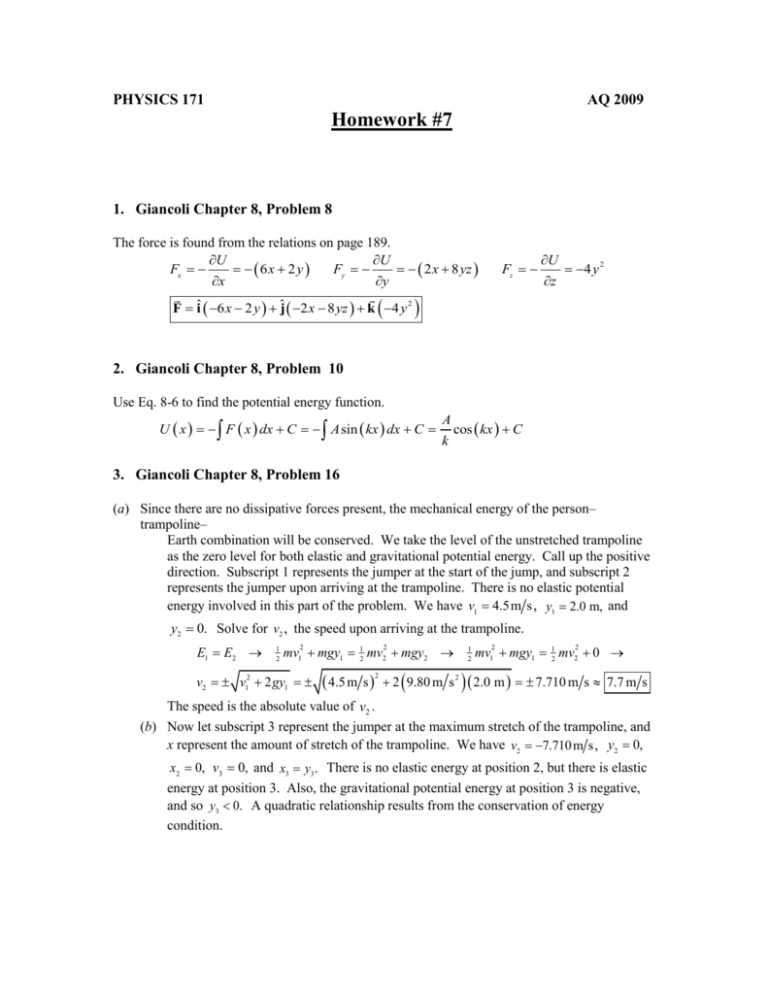
PHYSICS 171 AQ 2009 Homework #7 1. Giancoli Chapter 8, Problem 8 The force is found from the relations on page 189. U U Fx 6x 2 y Fy 2 x 8 yz x y F ˆi 6 x 2 y ˆj 2 x 8 yz k 4 y 2 Fz U z 4 y 2 2. Giancoli Chapter 8, Problem 10 Use Eq. 8-6 to find the potential energy function. U x F x dx C A sin kx dx C A k cos kx C 3. Giancoli Chapter 8, Problem 16 (a) Since there are no dissipative forces present, the mechanical energy of the person– trampoline– Earth combination will be conserved. We take the level of the unstretched trampoline as the zero level for both elastic and gravitational potential energy. Call up the positive direction. Subscript 1 represents the jumper at the start of the jump, and subscript 2 represents the jumper upon arriving at the trampoline. There is no elastic potential energy involved in this part of the problem. We have v1 4.5m s , y1 2.0 m, and y2 0. Solve for v2 , the speed upon arriving at the trampoline. E1 E2 1 2 mv12 mgy1 12 mv22 mgy2 v2 v12 2 gy1 4.5 m s 2 2 9.80 m s 2 1 2 mv12 mgy1 12 mv22 0 2.0 m 7.710 m s 7.7 m s The speed is the absolute value of v2 . (b) Now let subscript 3 represent the jumper at the maximum stretch of the trampoline, and x represent the amount of stretch of the trampoline. We have v2 7.710 m s , y2 0, x2 0, v3 0, and x3 y3. There is no elastic energy at position 2, but there is elastic energy at position 3. Also, the gravitational potential energy at position 3 is negative, and so y3 0. A quadratic relationship results from the conservation of energy condition. E2 E3 1 2 1 2 mv22 mgy2 12 kx22 12 mv32 mgy3 12 kx32 mv22 0 0 0 mgy3 12 ky32 y3 mg m 2 g 2 4 12 k 12 mv22 2 12 k 72 kg 9.80 m s 2 ky32 mgy3 12 mv22 0 1 2 72 kg 2 mg m 2 g 2 kmv22 k 9.80 m s 5.8 10 5.8 10 N m 2 2 4 N m 72 kg 7.71m s 4 0.284 m , 0.260 m Since y3 0 , y3 0.28 m . . The first term under the quadratic is about 500 times smaller than the second term, indicating that the problem could have been approximated by not even including gravitational potential energy for the final position. If that approximation were made, the result would have been found by taking the negative result from the following solution. E2 E3 1 2 m mv22 12 ky32 y3 v2 k 7.71m s 72 kg 5.8 104 N m 0.27 m 4. Giancoli Chapter 8, Problem 20 Since there are no dissipative forces present, the mechanical energy of the roller coaster will be conserved. Subscript 1 represents the coaster at point 1, etc. The height of point 2 is the zero location for gravitational potential energy. We have v1 0 and y1 32 m. Point 2: 1 2 mv12 mgy1 12 mv22 mgy2 ; y2 0 mgy1 12 mv22 v2 2 gy1 2 9.80 m s2 Point 3: 1 2 32 m 25m s mv12 mgy1 12 mv32 mgy3 ; y3 26 m mgy1 12 mv32 mgy3 v3 2 g y1 y3 2 9.80 m s2 Point 4: 1 2 6 m 11m s mv12 mgy1 12 mv42 mgy 4 ; y 4 14 m mgy1 12 mv42 mgy1 v4 2 g y1 y4 2 9.80 m s2 18 m 19 m s 5. Giancoli Chapter 8, Problem 22 Draw a free-body diagram for each block. Write Newton’s second law for each block. Notice that the acceleration of block A in the yA is 0 zero. Fy1 FN mA g cos 0 FN mA g cos F x1 FT mA g sin mAaxA 2 F y2 mB g FT mBa yB FT mB g a yB Since the blocks are connected by the cord, a yB a xA a. Substitute the expression for the tension force from the last equation into the x direction equation for block 1, and solve for the acceleration. mB g a mA g sin mA a mB g mA g sin mA a mBa ag m B mA sin mA mB 9.80 m s 2 5.0 kg 4.0 kg sin 32 9.0 kg 3.1m s 2 (b) Find the final speed of mB (which is also the final speed of mA ) using constant acceleration relationships. v 2f v02 2a y v 2f 2 g v f 2 gh m B mA sin mA m B m B mA sin mA m B 2 9.80 m s 2 h 0.75 m 5.0 kg 4.0 kg sin 32 9.0 kg 2.2 m s (c) Since there are no dissipative forces in the problem, the mechanical energy of the system is conserved. Subscript 1 represents the blocks at the release point, and subscript 2 represents the blocks when mB reaches the floor. The ground is the zero location for gravitational potential energy for mB , and the starting location for mA is its zero location for gravitational potential energy. Since mB falls a distance h, mA moves a distance h along the plane, and so rises a distance h sin . The starting speed is 0. E1 E2 0 mA gh 12 mA mB v22 mB gh sin mA mB sin mA mB v2 2 gh This is the same expression found in part (b), and so gives the same numeric result. 6. Giancoli Chapter 8, Problem 23 At the release point the mass has both kinetic energy and elastic potential energy. The total energy is 12 mv02 12 kx02 . If friction is to be ignored, then that total energy is constant. (a) The mass has its maximum speed at a displacement of 0, and so only has kinetic energy at that point. k 2 x0 m (b) The mass has a speed of 0 at its maximum stretch from equilibrium, and so only has potential energy at that point. 1 2 2 mv02 12 kx02 12 mvmax vmax v02 1 2 2 mv02 12 kx02 12 kxmax xmax x02 m k v02 7. Giancoli Chapter 8, Problem 36 (a) Use conservation of energy to equate the potential energy at the top of the circular track to the kinetic energy at the bottom of the circular track. Take the bottom of the track to the be 0 level for gravitational potential energy. 2 Etop Ebottom mgr 12 mvbottom vbottom 2 gr 2 9.80 m s 2 2.0 m 6.261m s 6.3m s (b) The thermal energy produced is the opposite of the work done by the friction force. In this situation, the force of friction is the weight of the object times the coefficient of kinetic friction. Ethermal Wfriction Ffriction x Ffriction x cos k mg x cos180 k mg x 0.251.0 kg 9.80 m s 2 3.0m 7.35J 7.4 J (c) The work done by friction is the change in kinetic energy of the block as it moves from point B to point C. Wfriction K K C K B 12 m vC2 vB2 vC 2Wfriction m vB2 2 7.35J 1.0 kg 6.261m s 4.9498 m s 4.9 m s 2 (d) Use conservation of energy to equate the kinetic energy when the block just contacts the spring with the potential energy when the spring is fully compressed and the block has no speed. There is no friction on the block while compressing the spring. 2 2 Einitial Efinal 12 mvcontact 12 kxmax k m 2 vcontact 2 xmax 4.9498 m s 2 1.0 kg 0.20 m 2 612.5 N m 610 N m 8. Giancoli Chapter 8, Problem 58 (a) The work to put m1 in place is 0, because it is still infinitely distant from the other two masses. Gm1m2 . The work to put m2 in place is the potential energy of the 2-mass system, r12 The work to put m3 in place is the potential energy of the m1 m3 combination, Gm1m3 , and the potential energy of the m2 m3 combination, r13 work is the sum of all of these potential energies, and so Gm1m2 Gm1m3 Gm2 m3 W r12 r13 r23 m1m2 W G m1m3 Gm2 m3 r23 . The total m2 m3 . Notice that the work is negative, which is a result r23 of the masses being gravitationally attracted towards each other. (b) This formula gives the potential energy of the entire system. Potential energy does not “belong” to a single object, but rather to the entire system of objects that interact to give the potential energy. r12 r13 m1m2 m1m3 m2 m3 is the binding energy of the system. It r13 r23 r12 (c) Actually, W G would take that much work (a positive quantity) to separate the masses infinitely far from each other. 9. Giancoli Chapter 8, Problem 73 The net rate of work done is the power, which can be found by P Fv mav. The velocity is dx dv 15.0t 2 16.0t 44 and a 30.0t 16.0. given by v dt dt (a) 2 2 P mav 0.28 kg 30.0 2.0 16.0 m s2 15.0 2.0 16.0 2.0 44 m s 197.1W 2.0 102 W (b) P mav 0.28 kg 30.0 4.0 16.0 m s2 15.0 4.0 16.0 4.0 44 m s 3844 W 3800 W The average net power input is the work done divided by the elapsed time. The work done is the change in kinetic energy. Note v 0 44 m s , v 2.0 15.0 2.0 16.0 2.0 44 16 m s , and 2 v 4.0 15.0 4.0 16.0 4.0 44 132 m s . 2 (c) Pavg K 0 to 2.0 (d) Pavg 2.0 to 4.0 t K t 1 2 m v 2f vi2 t 1 2 0.28 kg 16 m s 44 m s m v 2f vi2 t 2 1 2 2 2.0s 120 W 0.28 kg 132 m s 16 m s 1200 W 2 1 2 2.0s 2
